
Create a Powerful WhatsApp Marketing Strategy
August 24, 2021
What we can learn from successful large-scale marketing stunts
September 2, 2021Find out which Facebook ad types will best help you accomplish your social media business goals and maximize ROI.
Facebook advertisements work, which is why it’s the most popular platform for both B2C and B2B enterprises. Possibly a tad too well.
Despite recent controversies, Facebook is still the most popular social networking platform on the planet. Every day, more than one billion individuals visit Facebook. One of the most crucial aspects of any social media marketing approach is a Facebook advertisement. There’s a lot to sort out between formats, specs, placements, objectives, and calls-to-action.
The ad forms you can utilize are determined by your marketing goal. Your goal may have an impact on where your adverts appear (Facebook, Instagram, Messenger, Audience Network).
The essential distinctions and benefits of the most popular Facebook ad kinds will be covered in this article. Continue reading to find out which advertising will help you achieve your business goals and maximize your ROI.
Facebook ad types you should know
Photo adverts on Facebook
Because photos are so powerful, all Facebook ads are required to include one. They’ll be the first thing people see when they interact with your adverts.
That’s why a well-executed Facebook photo ad is frequently sufficient.
On Facebook, single picture ads are the simplest to create. Begin with a clear concept, then select or develop a striking image, and pair it with compelling language and a clear call to action. These advertisements may be used in a variety of Facebook settings, making them particularly useful for achieving brand awareness, engagement, reach and even shop visits.
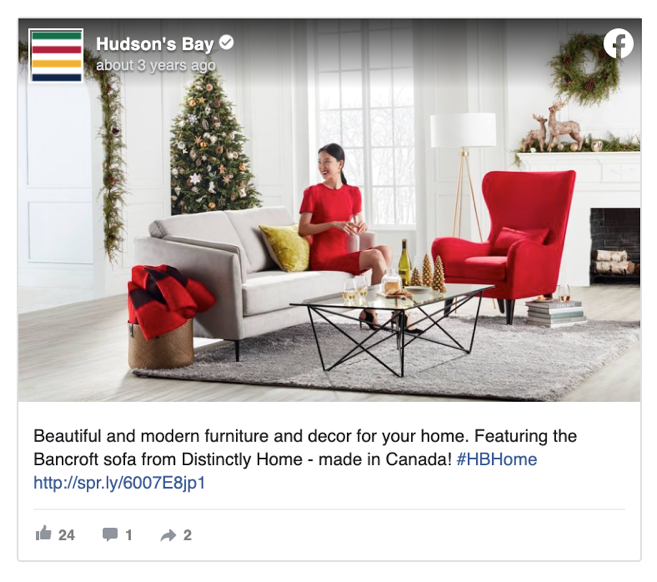
Facebook photo ad suggestions
- Pick a topic that interests you. Facebook suggests a variety of alternatives, including arrangements, individuals, and displays.
- Prioritize quality over quantity. There will be no images that are blurry, overexposed, or underexposed. Also, submit at the greatest feasible resolution.
- When feasible, utilize as little image text as possible. Images with fewer than 20% text perform better on Facebook, according to the company.
- Make sure you have a decent text-to-visual ratio by using Facebook’s Image Text Check tool.
- Use as little text as possible, especially in the thumbnail.
Specifications for a Facebook picture ad are as follows:
- 600 pixels is the minimum image width.
- 600 pixels is the minimum image height.
Slideshow, Carousel, and Collection advertising are the way to go if you want to feature more than one image.
Facebook video advertisements
On Facebook, video continues to reign dominant, particularly on mobile. In a recent earnings call, COO Sheryl Sandberg stated, “Winning on mobile now requires winning on video.”
According to a Facebook study, individuals watch videos for five times longer than they do static content. In addition, 30% of mobile buyers believe video is the greatest way to find new products.
Video ads are great for increasing reach, engagement, and sales, and they can go almost wherever a photo ad can, including Instagram.
Facebook video ad suggestions
- Use attention-getting thumbnail photos and titles.
- Quickly capture the audience’s attention. Before individuals decide to go on, you have an average of 1.7 seconds. 65 percent of viewers will watch for at least another 10 seconds if you can keep their attention beyond the initial three seconds.
- Keep your films brief and to the point. In a video campaign, the first three seconds can give up to 47% of the value, compared to 74% in the first ten seconds.
- Make your site mobile-friendly. The use of mobile-optimized Facebook videos has been found to increase brand recognition by 67%.
- Upload the highest-quality video you have.
- Use captions to make your videos more accessible. Captions have also been demonstrated to boost the amount of time spent watching videos.
- Make it so that the sound is turned off. The majority of video adverts in the mobile feed are muted.
- Explore other formats. Facebook 360 videos hold people’s attention for 40% longer than normal ones.
Specifications for Facebook video ads
- The majority of file formats are supported. The complete list may be seen here.
- 264 compression, square pixels, fixed frame rate, progressive scan, and stereo AAC audio compression at 128kbps+ are all recommended by Facebook.
- Make sure there is no letter or pillar boxing in your video (aka black bars).
- The maximum video file size is 4GB.
- Minimum video length: 1 second
- Maximum video length: 240 minutes
- Here’s a complete list of Facebook video ad specifications.
Ads for Facebook slideshows
Slideshow advertising combines the best photos and videos into a compact, cost-effective package. Slideshows, which Facebook refers to as “video-like” ads, are an easier alternative to video.
You might choose a Facebook Slideshow Ad for one of two reasons. This style lets you to add eye-catching motion to several photos without the production expenditures if you’re on a tight deadline or budget. You can either submit your own photographs or choose from Facebook’s stock photo collection.
Low-bandwidth slideshows, on the other hand, are an excellent alternative to video if your audience is located somewhere with slow internet rates. If you already have a video, simply upload it and choose the stills you want to utilize in a slideshow style.
Carousel ads on Facebook
The carousel ad format may be the ideal choice if you want to promote a variety of products or convey a story in sections. You can post between two and ten photographs or videos in this format, which people can swipe through.
Each slide in the carousel has a call to action, which is usually repeated throughout the final presentation. You can choose from 18 different call-to-action buttons, ranging from Call Now to Subscribe. The goals of supported carousel ads range from lead generation to driving in-store visits.
Carousel advertising can be found on Facebook and Instagram’s mobile and desktop News Feeds. A page, an event, the Ads Manager, or the Ads API can all be used to create them. Step-by-step instructions for making carousel advertising may be found here.
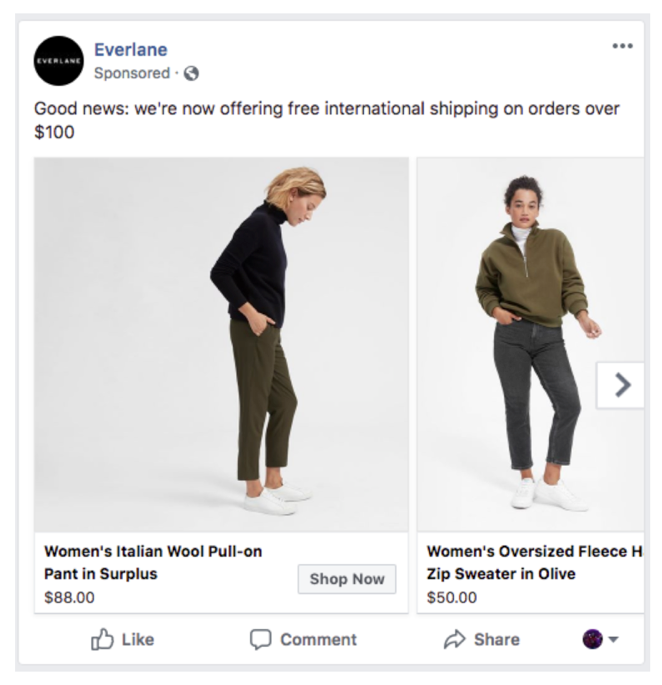
Tips for running a carousel ad on Facebook
- Make the most of the format. Use each slide to highlight a range, a sequence, or to tell a story.
- Use photos that are complementary to one another. Avoid using pictures that are visually incompatible or communicate an inconsistent brand story.
- When it makes sense, show your best-performing carousel cards first. It’s best to maintain them in sequence if you’re utilizing the structure to tell a tale.
- Be inventive. Target shared a cooking concept for each day of the week via a Facebook Carousel ad. Each slide was used by Betty Crocker to demonstrate a recipe step.
- Consider using a carousel ad to disperse a single long image. This can have a fantastic reinforcing effect if you’re trying to communicate something mysterious, panoramic, or epic in scope. Here’s how you can make your own.
- For ideas, go to Facebook Carousel’s Creative Examples page.
Facebook carousel ad specs
- Minimum number of cards: 2
- Maximum number of cards: 10
- Image file type: jpg or png
- Most video files types are supported
- Video maximum file size: 4GB
- Video length: up to 240 minutes
- Image maximum file size: 30MB
Advertisements for Facebook collection
Collection Ads are, in many ways, the eye-catching News Feed doorway to Instant Experience Ads.
This mobile-friendly hybrid style combines video, slideshows, and photos to increase traffic, conversions, and sales for your company.
A collection ad will usually include a hero image or video, as well as itemized product photos.
When a user clicks on a Collection Ad, they will be taken to a rich Instant Experience. This ad format is great for online merchants who want to convert interest into sales right away.
The following are some examples of collection ad templates:
- When you have four or more products to show off, use the Instant Storefront feature. When you want to push customers to your website or app to make a purchase, use this template as a mobile landing page.
- Use the lookbook to establish a brand story, show off your products in action, and encourage purchases.
- Use this template when you have a specific conversion objective in mind, such as visits to your website or other actions.
- Use this template to explain your brand story to new clients, which is ideal for brand awareness and consideration objectives. Alternatively, tell an old consumer a new narrative.
Instant Experiences on Facebook
Facebook Instant Experiences, also known as the “new and better Canvas,” is full-screen vertical adverts that are exclusively available on mobile devices.
The goal of this approach is to get your audience’s full attention. It even comes with Pixel, making re-engaging visitors a breeze.
Instant Experiences, as the name implies, are lightning-fast, loading 15 times faster than conventional mobile web pages. That’s significant, given that most pages take an average of 22 seconds to load, and half of the visitors leave after three seconds.
Instant Experiences become the rapid, post-click destination for in-app conversions and engagement when combined with any other Facebook ad style. The five Collection Ad designs are frequently the greatest choice because they’re built for Instant Experiences.
If you’re trying to capture leads and obtain contact information, and Instant Form template (previously known as a lead form) is also available.
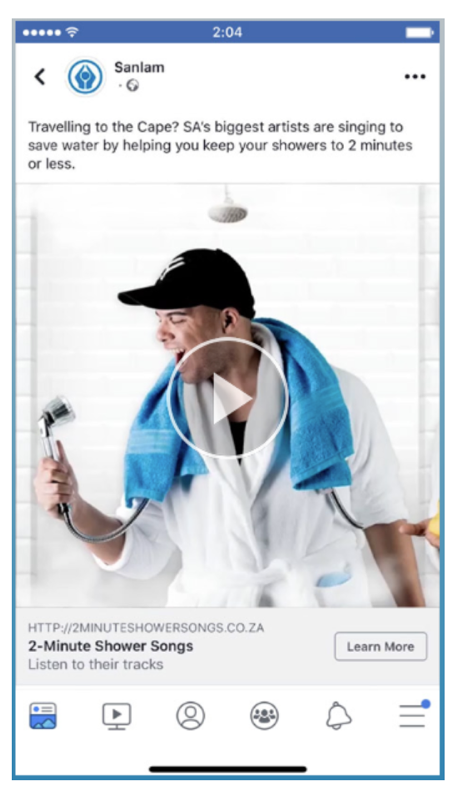
Tips for Facebook Instant Experiences
- Tell a unified story. The images on your cover should be complementary to the text that follows.
- Emphasize the variety of products available. The more eclectic your collection, the more likely you are to grab someone’s eye.
- Give individuals a reason to want to learn more. People are more likely to tap More when you display a selection of photos under your cover material.
- Provide clear instructions for viewers to follow.
- Throughout the experience, use the appropriate CTAs.
- Make your site mobile-friendly. Visitors with great intent will be disappointed by a poor mobile site.
- Experiment with different effects. Tilt-to-pan effects and product-tagged photos are among the new Instant Experiences capabilities.
- Put the URL parameters in the right place. These deep links will be able to track product and other page visits as well as your website’s link.
Advertisements on Facebook Stories
Stories are full-screen photos or movies that, unless saved, vanish after 24 hours. Instagram Stories may be more well-known due to their popularity, but Facebook Stories are also worth considering, especially because they’re the fastest-growing ad format. More than half of those who use Facebook, Messenger, Whatsapp, and Instagram stories say they’ve increased their online purchases as a result.
In a recent study, Facebook found that after seeing a product or service in Stories:
56% browsed the brand’s website to get more information
50% looked for the product or services on websites that sell it
38% talked to someone about the product or service
34% visited a store to check out the product or service
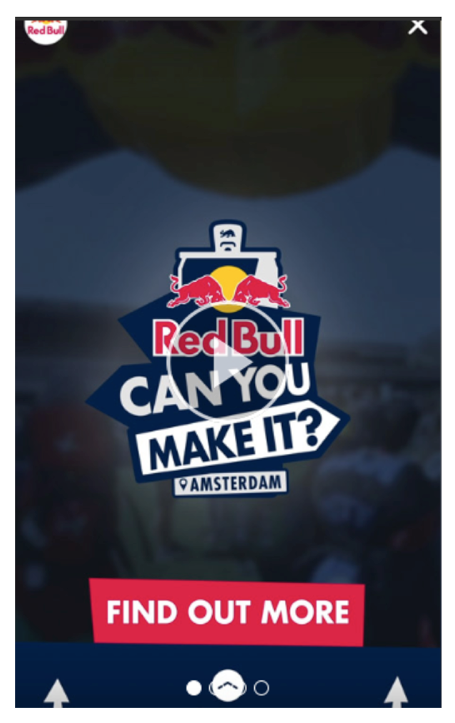
When generating an ad, Facebook Stories cannot be selected as a standalone placement. When you choose Automatic Placements, it will be included under placements.
However, you must use a Facebook Stories-compatible aim for it to work (reach, traffic, app installs, video views, conversions, brand awareness, lead generation).
Instant Forms are also compatible with Facebook Stories, where they appear as simple polls to complete.
Facebook Stories ads specs
- Image aspect ratio: 9:16 to 1.91:1
- Maximum image duration: 6 seconds.
- Maximum image file size: 30 MB.
- Supported image type: .jpg and .png
- Video aspect ratio: 9:16 to 1.91:1
- Maximum video width: 500 px
- Maximum video duration: 15 seconds
- Maximum video file size: 4 GB
- Supported video types: .mp4 and .mov
*Captions are not available. Make them a part of the file if you plan to include them.
Use the Ads Manager or the API to create ads in Facebook Stories.
Advertisements on Facebook Messenger
In terms of downloads, Facebook Messenger, not Facebook, is the most popular mobile app. You could be missing out if you don’t have a Messenger ad plan. These advertisements display in a user’s inbox and can take the shape of an image carousel, video, or dynamic adverts.
By selecting Messenger Inbox as a placement for your campaign, you can create inbox advertising. However, according to Facebook, using automatic placements is the ideal approach to set up Messenger advertising.
Automatic placements direct ads to the location most likely to produce the best results for the least amount of money.
If your business uses Messenger, Click-to-Messenger ads could be beneficial. These advertisements bring people into immediate contact with your company.
You may also deliver Sponsored Messages to customers who have already interacted with your business on Messenger. Like any other message, these will display in their inbox’s conversation thread.
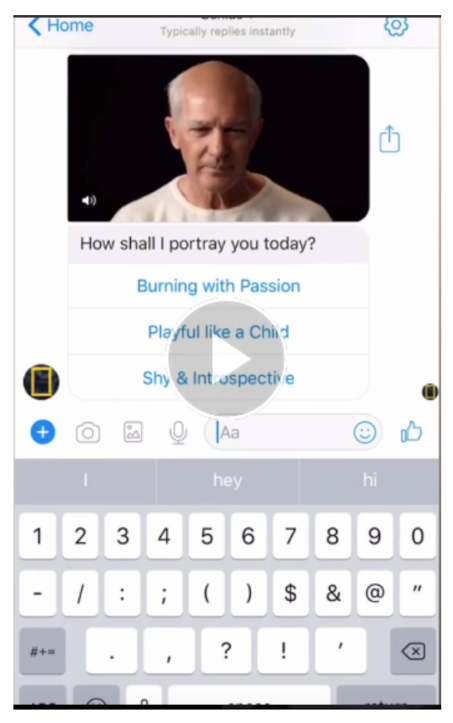
Lead ads on Facebook
Lead advertising can be used to acquire customers for a variety of reasons, including newsletter subscriptions, quote requests, and event registration.
When someone clicks on a lead ad, they’re given a context card with more information. This is where you may tell people about your company, your offer, and why they should give you their personal information.
The contact information is pre-populated, making it easy for people to sign up and resulting in a low drop-off rate. You may also add custom questions to learn more about your audience.
Lead ads on Facebook can be established either through your Page or through Ads Manager. Find out how to make one here.
Tips for running a Facebook lead ad
- Keep it short and sweet. Conversion rates are lower when forms are long.
- Open-ended queries should be avoided. These questions are more difficult and require longer to answer, resulting in a higher drop-off rate. Use multiple-choice questions.
- Don’t give your customers too many options. Stick to three to four options for multiple-choice questions.
- Thank you. To demonstrate your gratitude, include a personalized “thank you.”
Dynamic adverts on Facebook
Marketers can use dynamic advertisements to push products from any catalog to consumers who have expressed interest on your website, in your app, or elsewhere on the internet. Image, carousel, and collection advertising are all examples of dynamic ads.
Dynamic advertising varies in that instead of producing separate ads for each product, you can develop a template that gathers photos and information from your catalog automatically.
So, if a visitor to your website looks at a pair of shoes, the dynamic ad will retarget them with the same information without you having to upload images or material.
Facebook ad tips for dynamic ads
- Create your catalog. Double-check Facebook’s catalog specs to make sure your inventory is ready to be dynamically drawn from.
- Pixel should be used. Facebook Pixel must be installed on your website for dynamic advertisements to operate.
- Updates should be scheduled. If your catalog changes frequently, schedule uploads to keep your prices and stock figures up to date.
Advertisements on Facebook with links
The purpose of link advertisements is to get visitors to visit your website.
Butterfingers or mouse slippages aren’t an issue because every component of the link ad is clickable. This could explain why firms employing Facebook Link Ads have achieved a 53 percent return on investment.
Facebook link ad tips
- Choose a winning image. High-quality, vibrant, clear photos always perform best.
- Prompt with a crisp copy. A sharp headline and descriptive text will help inspire clicks.
- Include a CTA Button. Choose from: Shop Now, Learn More, Sign Up, Book Now, and Download.
- Describe the destination. Tell your customers where their click will take them, that way they click with purpose.
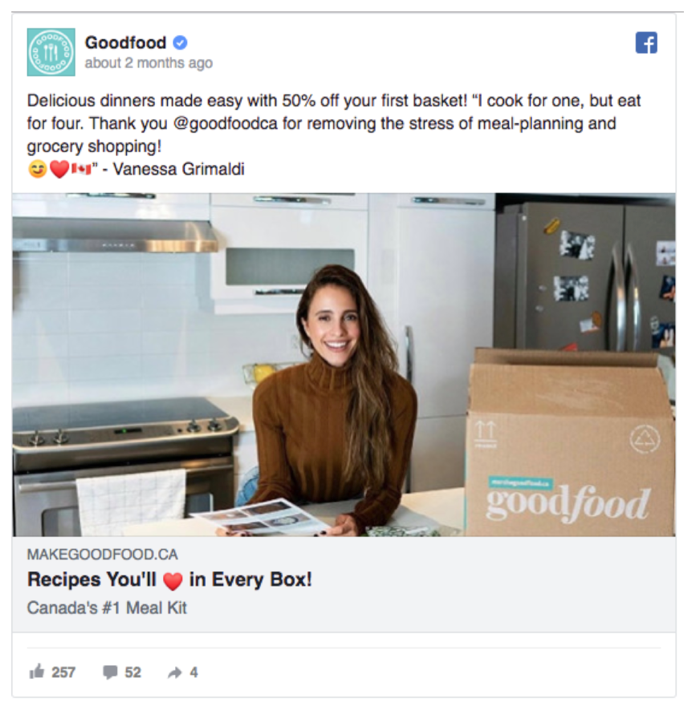
Are you ready to start building your own Facebook ad campaigns? Take a look at some of the best Facebook ad examples from major brands to get some ideas.


